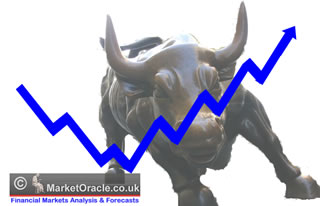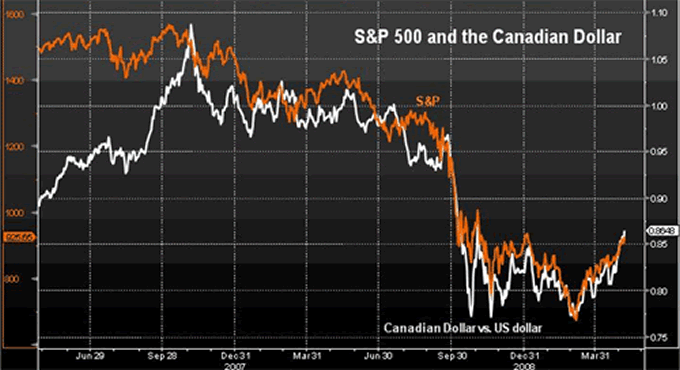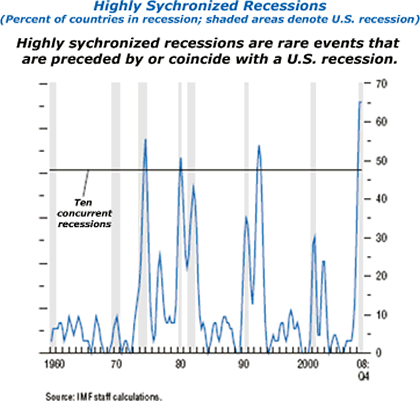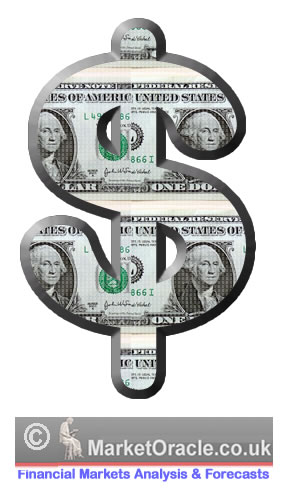U.S. Dollar and Stock Market Will Show Real Stress Test Results
Stock-Markets / Financial Markets 2009 May 10, 2009 - 08:03 PM GMT Bryan Rich writes: In times of stress you can’t rely on normal conditions to hold. In fact, reactions to stress can be quite the opposite … completely unpredictable.
Bryan Rich writes: In times of stress you can’t rely on normal conditions to hold. In fact, reactions to stress can be quite the opposite … completely unpredictable.
It’s no different in financial markets.
During normal conditions, you have a good grasp on expectations of how markets relate to each other and how one market might respond to certain conditions relative to another. With this information you can build a diverse portfolio that gives you a level of protection against vulnerabilities in individual markets or securities.
But in times of crisis, these historical relationships can go awry. And the current crisis has exposed the “shock” risk of this diversification philosophy. No region, nor market, was spared.
 |
| The U.S. stock market has become a proxy for recovery. And right now, all eyes are on stocks. |
Now new “post-shock” relationships have developed in the currency markets, where foreign currencies are trading in a tight relationship with the U.S. stock market. When stocks are moving lower, the dollar is moving higher. And when stocks are moving higher, nearly all currencies (except the dollar) are following.
The gist is, the U.S. stock market has become a proxy for recovery. And in a global economy dependent upon a U.S. recovery, all eyes are on stocks.
The Canadian Dollar is a Perfect Example …
Canada has had a recent pick up in manufacturing and housing activity. And the Canadian banking system is known to be in superior condition to that of the U.S. banks. That might appear to be the reason the Canadian dollar (CAD) has had a nice climb and is breaking out against the dollar.
Yet its rise is not fundamentally driven …
The Canadian economy is contracting at a steeper, annualized rate than the U.S. Consequently, the Bank of Canada has been aggressively lowering interest rates following the policy decisions made in the U.S., the UK and Japan. To add to the Canadian dollar’s woes is the fact that Canada is highly dependent upon trade with the United States, which has softened from a weak U.S. consumer.
Despite all the problems, the CAD is still strengthening, because it has everything to do with this stock market proxy of economic recovery in the U.S.
As you can see in the chart below, when the S&P 500 Index topped in November 2007, the Canadian dollar began mirroring the index and the relationship became even tighter as the crisis intensified toward the end of last year. And now that stocks are in rally mode — so is the Canadian dollar, in lock-step.

So if currencies are trading off of U.S. stocks, and U.S. stocks are signaling a perception of recovery, then it’s a good idea to know what the real prospects are for recovery.
What Does Recovery Look Like for the Worst Economy Since the Great Depression?
According to the IMF, Fed Chairman Bernanke’s projection of a recovery toward the end of the year is taking the absolute best case scenario.
Here’s why …
There have been three other recessions in the past fifty years that share the two key features of this recession:
1. Global synchronization — In globally-synchronized recessions there is an absence of global trade, a typical crutch for ailing economies to lean on. This time around is a doozie … a whopping 65 percent of world economies are in a recession, and global trade has taken a header.
2. Financial crisis — In recessions associated with a financial crisis, the recoveries are slower because households are in saving mode, so demand is weak. According to the Bureau of Economic Analysis, the personal savings rate in the U.S. is now more than 4 percent, the highest this decade — and it’s likely headed higher.
In this type of recession, the decline tends to be the steepest, the length of recession tends to be the longest, and the recovery tends to be the slowest compared to other historical recessions. You can see this in the following chart …
 |
With the present crisis, we should expect a contraction in GDP of nearly 5 percent, 2 years of recession and 3½ years of sluggish recovery until levels of pre-recession output return. So based on the IMF’s study of 122 historical recessions, advanced economies should expect 5+ years of weak economic activity.
The Real Stress Test
There has been a noticeable effort by U.S. officials to impart calm and confidence. And the rally that has taken place in the stock market has given consumers, investors and businesses a sense of stability.
The stock market has climbed 39 percent from its lows. And with it, foreign currencies have bounced against the dollar, Treasuries have fallen and the broad commodities markets have begun to climb off their lows.
Put simply, the financial markets are reflecting way too much optimism. It’s this type of exuberance that could exacerbate another decline across markets. And another severe decline in financial markets could be a major set-back for the global economy.
When confidence falls again, it will be that much harder to restore. And when the economy is finally structurally ready to stage a recovery, it will be that much more sluggish with the absence of confidence.
 |
| Global markets and economies are vulnerable to another shock. So expect another breakdown in the stock market and a swift surge in the U.S. dollar. |
All of this makes markets and economies more vulnerable to another shock.
Understanding risks in this environment is paramount. However, trading currencies is not an exact science. It’s a constant evaluation of: Risks versus potential rewards, market sentiment, global capital flows, price patterns and tendencies, relative economic performance, the political landscape and perhaps most important, vulnerabilities.
While prices are saying one thing, the underlying risks are saying another. The vulnerability is squarely toward more downside and more uncertainty. And this means you should expect another breakdown in the stock market and a swift surge in the U.S. dollar as a result.
Regards,
Bryan
This investment news is brought to you by Money and Markets . Money and Markets is a free daily investment newsletter from Martin D. Weiss and Weiss Research analysts offering the latest investing news and financial insights for the stock market, including tips and advice on investing in gold, energy and oil. Dr. Weiss is a leader in the fields of investing, interest rates, financial safety and economic forecasting. To view archives or subscribe, visit http://www.moneyandmarkets.com .
Money and Markets Archive |
© 2005-2022 http://www.MarketOracle.co.uk - The Market Oracle is a FREE Daily Financial Markets Analysis & Forecasting online publication.



